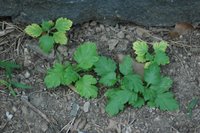

Artemisia vulgaris, Mugwort, in the sunny border at Garden #4 in Flatbush, Brooklyn, New York. The first photo shows the habit of growth. For scale, the stepping stones are 11" square. The plants in this photo are about two to two-and-a-half feet tall.
The second photo shows an entire plant removed from this area. You can see the horizontal root below and to the right. The plant regenerates if any part of this root remains in the soil.
After taking these photos I removed all the plants.
Photos taken: June 4, 2006.
The second photo shows an entire plant removed from this area. You can see the horizontal root below and to the right. The plant regenerates if any part of this root remains in the soil.
After taking these photos I removed all the plants.
Photos taken: June 4, 2006.

This photo shows what you get less than 20 days later if you don't get all the roots out!
Photo taken: June 23, 2006
Photo taken: June 23, 2006
Artemisia Vulgaris, Common wormwood or Mugwort, is a perennial herbaceous (at least in Zone 7a) plant in the Asteraceae (Compositae), the Aster, Daisy or Sunflower family.
The emerging foliage, as seen in the third photo above, looks like Chrysanthemum. The maturing plants, as in the first two photos, remind me of ragweed. The pleasant (to me), pungent scent of the leaves alone identifies it as an Artemisia, a sage. The semi-woody stems and distinctive scent distinguish it from Chrysanthemum or ragweed.
The flowers individually are insigificant. When in bloom, collectively the flowers don't offer much either, forming just a greyness around the tops of the plants, as if they had lint stuck between their leaves. I've seen some listings of more ornamental selections with more prominent flowers, and even one with variegated leaves.
"Wort" is an old suffix for plants traditionally used for medicinal and healing purposes, for example: Lungwort. I don't know what "Mug" identifies that would need healing. It also has culinary uses as a seasoning. It's widely available commercially, sold as an herb. You're welcome to have mine for free, if there's any left after I'm done ripping it out. Artemisias also have toxic properties. Among other applications, A. vulgaris has been used as a natural abortifacient in early pregnancy. Another well-known member of the genus is A. absinthium, Absinthe.
It has escaped cultivation and is reproducing in the wild. Several sources categorize it as invasive. Once established, it can be difficult to eliminate through mechanical means. It's common along roadsides in New York City. The photos from my garden above show the long, rambling root system, and how easily it regrows from any small part of the root left behind. I expect to be pulling this up for years from my garden, until I've exhausted it.
References:
- USDA PLANTS Database: Symbol ARVUV
- Wikipedia: Artemisia vulgaris

I just took the train back and forth to NYC from the Erie PA area and I saw a lot of this plant by the tracks, in some places it was the dominant species.
ReplyDelete